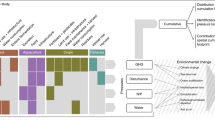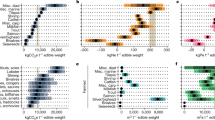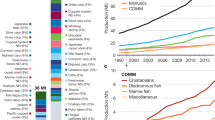Abstract
The net environmental implications of shifting aquaculture feed provisioning from wild-caught fishmeal to crop-based ingredients remain understudied, with little attention paid to multiple environmental pressures or the importance of where ingredients are sourced from. Here we model the change in environmental footprint (a cumulative and spatial measure of greenhouse gas emissions, habitat disturbance, excess nutrient and water consumption pressures) of shifting dependence from largely fish-based to plant-based ingredients in feeds for Atlantic salmon farming. We show that average differences exist between feeds in their cumulative and individual environmental pressures, but more importantly, the locations where feed raw materials are produced and processed drives far more variability in footprint within a feed than the typical variation between feeds. We demonstrate that responsible sourcing will be critical for sustainable feed production across all farming systems as the next generation of ingredients is developed.
This is a preview of subscription content, access via your institution
Access options
Access Nature and 54 other Nature Portfolio journals
Get Nature+, our best-value online-access subscription
$32.99 / 30 days
cancel any time
Subscribe to this journal
Receive 12 digital issues and online access to articles
$119.00 per year
only $9.92 per issue
Buy this article
- Purchase on SpringerLink
- Instant access to full article PDF
Prices may be subject to local taxes which are calculated during checkout





Similar content being viewed by others
Data availability
All publicly accessible data are freely available at https://github.com/Sustainable-Aquafeeds-Project/feed_pressure_mapping. Large data files are available from figshare via https://doi.org/10.6084/m9.figshare.29828360 (ref. 70). We are unable to make life-cycle analysis data containing per-unit pressure information publicly available and this should be obtained from the corresponding author to run the full analysis. We detail instructions on how to obtain these data and maintain correct file paths for the code in the Github repository ReadMe file. Source data for all figures are provided in the online version of this article. Source data are provided with this paper.
Code availability
All code used in this analysis is available at https://github.com/Sustainable-Aquafeeds-Project/feed_pressure_mapping. Please follow directions for use in the ReadMe file. This repository should be cloned from Github and run in the R project to ensure file paths are functional.
References
The State of World Fisheries and Aquaculture 2022: Towards Blue Transformation (FAO, 2022); https://doi.org/10.4060/cc0461en
Turchini, G. M., Trushenski, J. T. & Glencross, B. D. Thoughts for the future of aquaculture nutrition: realigning perspectives to reflect contemporary issues related to judicious use of marine resources in aquafeeds. North Am. J. Aquac. 81, 13–39 (2019).
Troell, M. et al. Does aquaculture add resilience to the global food system? Proc. Natl Acad. Sci. USA 111, 13257–13263 (2014).
Tacon, A. G. & Metian, M. Global overview on the use of fish meal and fish oil in industrially compounded aquafeeds: trends and future prospects. Aquaculture 285, 146–158 (2008).
Froehlich, H. E., Jacobsen, N. S., Essington, T. E., Clavelle, T. & Halpern, B. S. Avoiding the ecological limits of forage fish for fed aquaculture. Nat. Sustain. 1, 298–303 (2018).
Naylor, R. L. et al. A 20-year retrospective review of global aquaculture. Nature 591, 551–563 (2021).
Merino, G. et al. Can marine fisheries and aquaculture meet fish demand from a growing human population in a changing climate? Glob. Environ. Change 22, 795–806 (2012).
Aas, T. S., Åsgård, T. & Ytrestøyl, T. Utilization of feed resources in the production of Atlantic salmon (Salmo salar) in Norway: an update for 2020. Aquac. Rep. 26, 101316 (2022).
Ytrestøyl, T., Aas, T. S. & Åsgård, T. Utilisation of feed resources in production of Atlantic salmon (Salmo salar) in Norway. Aquaculture 448, 365–374 (2015).
Cottrell, R. S., Blanchard, J. L., Halpern, B. S., Metian, M. & Froehlich, H. E. Global adoption of novel aquaculture feeds could substantially reduce forage fish demand by 2030. Nat. Food 1, 301–308 (2020).
Rocker, M. M., Mock, T. S., Turchini, G. M. & Francis, D. S. The judicious use of finite marine resources can sustain Atlantic salmon (Salmo salar) aquaculture to 2100 and beyond. Nat. Food 3, 644–649 (2022).
Cottrell, R. S. et al. Time to rethink trophic levels in aquaculture policy. Rev. Aquac. 13, 1583–1593 (2021).
Froehlich, H. E., Runge, C. A., Gentry, R. R., Gaines, S. D. & Halpern, B. S. Comparative terrestrial feed and land use of an aquaculture-dominant world. Proc. Natl Acad. Sci. USA 115, 5295–5300 (2018).
Pahlow, M., Van Oel, P., Mekonnen, M. & Hoekstra, A. Y. Increasing pressure on freshwater resources due to terrestrial feed ingredients for aquaculture production. Sci. Total Environ. 536, 847–857 (2015).
Fry, J. P. et al. Environmental health impacts of feeding crops to farmed fish. Environ. Int. 91, 201–214 (2016).
Newton, R. W. & Little, D. C. Mapping the impacts of farmed Scottish salmon from a life cycle perspective. Int. J. Life Cycle Assess. 23, 1018–1029 (2018).
Aquaculture Facility Certification: Feed Mills. Best Aquaculture Practices Certification Standards, Guidelines (BAP, 2022).
ASC Feed Standard. Version 1.01, January 2023 (ASC, 2023).
Soy Vendors to the Salmon Industry End Trade of Deforestation Linked Soy in Brazil (Norwegian Seafood Council, 2021); https://www.mynewsdesk.com/seafood/documents/international-press-release-soya-brazil-jan2021-dot-pdf-279547
Halpern, B. S. et al. The environmental footprint of global food production. Nat. Sustain. 5, 1027–1039 (2022).
Kuempel, C. D. et al. Integrating life cycle and impact assessments to map food’s cumulative environmental footprint. One Earth 3, 65–78 (2020).
Kuempel, C. D. et al. Environmental footprints of farmed chicken and salmon bridge the land and sea. Curr. Biol. 33, 990–997.e4 (2023).
Blonk, H. et al. Agrifootprint 6—Methodology Report (Blonk, 2022); https://simapro.com/wp-content/uploads/2023/03/FINAL-Agri-footprint-6-Methodology-Report-Part-1-Methodology-and-Basic-Principles-Version-2.pdf
Flynn, H. C. et al. Quantifying global greenhouse gas emissions from land-use change for crop production. Glob. Change Biol. 18, 1622–1635 (2012).
Cao, L. et al. China’s aquaculture and the world’s wild fisheries. Science 347, 133–135 (2015).
Naylor, R. L. et al. Effect of aquaculture on world fish supplies. Nature 405, 1017–1024 (2000).
Macedo, M. N. et al. Decoupling of deforestation and soy production in the southern Amazon during the late 2000s. Proc. Natl Acad. Sci. USA 109, 1341–1346 (2012).
Testa, G., Neira, S., Giesecke, R. & Piñones, A. Projecting environmental and krill fishery impacts on the Antarctic Peninsula food web in 2100. Prog. Oceanogr. 206, 102862 (2022).
Meijaard, E. et al. The environmental impacts of palm oil in context. Nat. Plants 6, 1418–1426 (2020).
Poore, J. & Nemecek, T. Reducing food’s environmental impacts through producers and consumers. Science 360, 987–992 (2018).
Gephart, J. A. et al. Environmental performance of blue foods. Nature 597, 360–365 (2021).
Bohnes, F. A., Hauschild, M. Z., Schlundt, J. & Laurent, A. Life cycle assessments of aquaculture systems: a critical review of reported findings with recommendations for policy and system development. Rev. Aquac. 11, 1061–1079 (2019).
Ziegler, F. et al. Greenhouse gas emission reduction opportunities for the Norwegian salmon farming sector—can they outweigh growth? Aquaculture 581, 740431 (2024).
Ghamkhar, R. & Hicks, A. Comparative environmental impact assessment of aquafeed production: sustainability implications of forage fish meal and oil free diets. Resour. Conserv. Recycl. 161, 104849 (2020).
Henriksson, P. J. G. et al. Interventions for improving the productivity and environmental performance of global aquaculture for future food security. One Earth 4, 1220–1232 (2021).
Carter, C. G. & Codabaccus, M. B. Assessing the value of single-cell ingredients in aquafeeds. Curr. Opin. Biotechnol. 76, 102734 (2022).
Oonincx, D. G., Van Broekhoven, S., Van Huis, A. & van Loon, J. J. Feed conversion, survival and development, and composition of four insect species on diets composed of food by-products. PLoS ONE 10, e0144601 (2015).
Van Huis, A. & Oonincx, D. G. The environmental sustainability of insects as food and feed. A review. Agron. Sustain. Dev. 37, 43 (2017).
Davis, D., Morao, A., Johnson, J. K. & Shen, L. Life cycle assessment of heterotrophic algae omega-3. Algal Res. 60, 102494 (2021).
Belton, B. et al. Farming fish in the sea will not nourish the world. Nat. Commun. 11, 5804 (2020).
Cashion, T., Tyedmers, P. & Parker, R. W. R. Global reduction fisheries and their products in the context of sustainable limits. Fish Fish 18, 1026–1037 (2017).
Halpern, B. S. et al. Reply to: the environmental footprint of fisheries. Nat. Sustain. 6, 1314–1315 (2023).
Cavan, E. L. & Hill, S. L. Commercial fishery disturbance of the global ocean biological carbon sink. Glob. Change Biol. 28, 1212–1221 (2022).
Bianchi, D., Carozza, D. A., Galbraith, E. D., Guiet, J. & DeVries, T. Estimating global biomass and biogeochemical cycling of marine fish with and without fishing. Sci. Adv. 7, eabd7554 (2021).
Godar, J. & Gardner, T. in Telecoupling: Exploring Land-Use Change in a Globalised World (eds Friis, C. & Nielsen, J. Ø.) 149–175 (Springer, 2019).
Liu, J. et al. Framing sustainability in a telecoupled world. Ecol. Soc. http://www.jstor.org/stable/26269331 (2013).
Cannon, J. et al. Fishery improvement projects: performance over the past decade. Mar. Policy 97, 179–187 (2018).
Crona, B., Käll, S. & Van Holt, T. Fishery Improvement Projects as a governance tool for fisheries sustainability: a global comparative analysis. PLoS ONE 14, e0223054 (2019).
Cottrell, R. S. et al. Food production shocks across land and sea. Nat. Sustain. 2, 130–137 (2019).
Walker, B. et al. Response diversity as a sustainability strategy. Nat. Sustain. 6, 621–629 (2023).
Sun, Z., Scherer, L., Zhang, Q. & Behrens, P. Adoption of plant-based diets across Europe can improve food resilience against the Russia–Ukraine conflict. Nat. Food 3, 905–910 (2022).
Blanchard, J. L. et al. Detecting, attributing, and projecting global marine ecosystem and fisheries change: FishMIP 2.0. Earths Future 12, e2023EF004402 (2024).
Maury, O. et al. The Ocean System Pathways (OSPs): a new scenario and simulation framework to investigate the future of the world fisheries. Earths Future 13, e2024EF004851 (2025).
Leclère, D. et al. Bending the curve of terrestrial biodiversity needs an integrated strategy. Nature 585, 551–556 (2020).
R Core Team. R: A Language and Environment for Statistical Computing (R Foundation for Statistical Computing, 2023).
Naylor, R. L. et al. Feeding aquaculture in an era of finite resources. Proc. Natl Acad. Sci. USA 106, 15103–15110 (2009).
Tacon, A. G. & Metian, M. Feed matters: satisfying the feed demand of aquaculture. Rev. Fish. Sci. Aquac. 23, 1–10 (2015).
Fishery and Aquaculture Statistics. Global Fish Trade—All Partners Aggregated 1976–2020 (FishStatJ) (FAO, 2022).
Kok, B. et al. Fish as feed: using economic allocation to quantify the fish in:fish out ratio of major fed aquaculture species. Aquaculture 528, 735474 (2020).
Ayer, N. W., Tyedmers, P. H., Pelletier, N. L., Sonesson, U. & Scholz, A. Co-product allocation in life cycle assessments of seafood production systems: review of problems and strategies. Int. J. Life Cycle Assess. 12, 480–487 (2007).
Mackenzie, S. G., Leinonen, I. & Kyriazakis, I. The need for co-product allocation in the life cycle assessment of agricultural systems—is ‘biophysical’ allocation progress? Int. J. Life Cycle Assess. 22, 128–137 (2017).
Knuckey, I., Sinclair, C., Surapaneni, A. & Ashcroft, W. Utilisation of seafood processing waste—challenges and opportunities. In SuperSoil2004: 3rd Australian New Zealand Soils Conference (2004).
FAOSTAT. Crop and Livestock Production Statistics (FAO, 2022).
Biomar Sustainability Report 2022 (Biomar, 2022); https://www.biomar.com/en/global/sustainability/sustainability-report/#refid-52229
Yu, Q. et al. A cultivated planet in 2010—part 2: the global gridded agricultural-production maps. Earth Syst. Sci. Data 12, 3545–3572 (2020).
Watson, R. A. & Tidd, A. Mapping nearly a century and a half of global marine fishing: 1869–2015. Mar. Policy 93, 171–177 (2018).
Parker, R. W. et al. Fuel use and greenhouse gas emissions of world fisheries. Nat. Clim. Change 8, 333–337 (2018).
Boettiger, C., Lang, D. T. & Wainwright, P. rfishbase: exploring, manipulating and visualizing FishBase data from R. J. Fish Biol. 81, 2030–2039 (2012).
O’Malley, R. Standard VGPM (Ocean Productivity, 2023); http://orca.science.oregonstate.edu/2160.by.4320.monthly.xyz.vgpm.m.chl.m.sst.php
Cottrell, R. large_data. figshare https://doi.org/10.6084/m9.figshare.29828360 (2025).
Acknowledgements
This work was supported by the Australian Research Council Linkage Project LP200100404 ‘Optimising aquafeeds to support ecosystem-based management’ (R.S.C., J.L.B., S.S.P., G.C.). G.C. is supported through an Australian Research Training Program Scholarship and the UTAS-CSIRO Quantitative Marine Science Program. B.S.H. and G.C. also received support from the Zegar Family Foundation. X.Z. is supported through Destinations Australia and a Tasmanian Graduate Research Scholarship.
Author information
Authors and Affiliations
Contributions
R.S.C., J.L.B, B.S.H., H.A.H. and M.C. conceptualized the work. R.S.C., B.S.H, J.L.B. and B.P. developed the methodology. R.S.C., H.A.H., M.C. and G.C. contributed the data products needed for analysis. R.S.C. and M.C. conducted analyses. R.S.C. and G.C. produced the figures. All authors provided feedback to conceptual and methodological refinement, and provided edits for the paper. J.L.B., B.S.H., C.M., C.G.C., D.D.C., L.A. and J.P.B. acquired the broader project funding.
Corresponding author
Ethics declarations
Competing interests
R.S.C., J.L.B., B.S.H., B.P., L.A., D.D.C., C.G.C. and C.M. acknowledge a relationship with Biomar Group via their role as industry partners on Australian Research Council Linkage Project LP200100404. L.A. and C.G.C acknowledge a relationship with Skretting via the Blue Economy Cooperative Research Centre supported under the Australian Government’s CRC Program, grant number CRC-20180101. H.A.H., M.C. and T.F-S. acknowledge employment with Biomar Group. The other authors declare no competing interests.
Peer review
Peer review information
Nature Food thanks Markus Langeland, Brandi McKuin, Michael Tlusty and the other, anonymous, reviewer(s) for their contribution to the peer review of this work.
Additional information
Publisher’s note Springer Nature remains neutral with regard to jurisdictional claims in published maps and institutional affiliations.
Supplementary information
Supplementary Information
Supplementary Figs. 1–11 and Tables 1, 2, 4, 5 and 7.
Supplementary Tables
Supplementary tables holding data on: the drivers of embodied fish demand, greenhouse gas emissions from fishing activities in different marine regions, partitioning and raw material conversion factors for agricultural and marine ingredients, and process names used in Agri-footprint for environmental pressure estimation.
Source data
Source Data Fig. 2a
Raster file underpinning Fig. 2a.
Source Data Fig. 2b
Raster file underpinning Fig. 2b.
Source Data Fig. 2c
Raster file underpinning Fig. 2c.
Source Data Fig. 2d
Raster file underpinning Fig. 2d.
Source Data Fig. 2e
Raster file underpinning Fig. 2e.
Source Data Fig. 2f
Raster file underpinning Fig. 2f.
Source Data Fig. 3
All iterations of cumulative environmental footprint per diet underpinning Fig. 3.
Source Data Fig. 4
All iterations of greenhouse gas emissions, disturbance, water extraction, and nutrient pollution per diet underpinning Fig. 4.
Source Data Fig. 5
Pressure data underpinning the case studies in Fig. 5.
Rights and permissions
Springer Nature or its licensor (e.g. a society or other partner) holds exclusive rights to this article under a publishing agreement with the author(s) or other rightsholder(s); author self-archiving of the accepted manuscript version of this article is solely governed by the terms of such publishing agreement and applicable law.
About this article
Cite this article
Cottrell, R.S., Halpern, B.S., Cormery, M. et al. The origins of aquaculture feed ingredients matter more than composition for aquafeed environmental footprint assessments. Nat Food (2025). https://doi.org/10.1038/s43016-025-01236-6
Received:
Accepted:
Published:
DOI: https://doi.org/10.1038/s43016-025-01236-6



